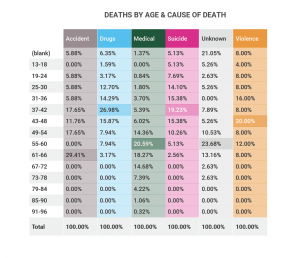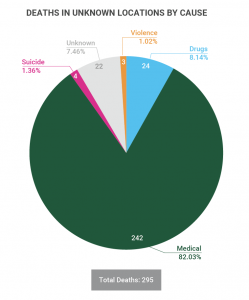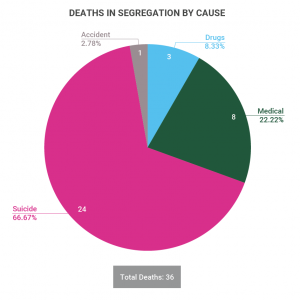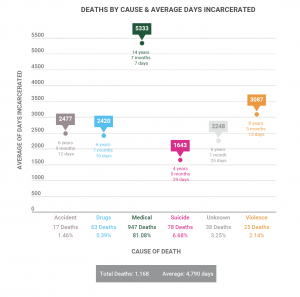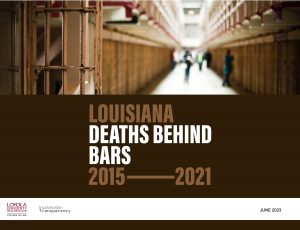
Report Excerpts
From 2015 to 2021, at least 1,168 incarcerated people died behind bars in prisons, jails, and youth detention centers across Louisiana. This report is the second comprehensive collection and analysis of deaths behind bars in Louisiana, based on public records requests filed with 122 facilities across the state and six coroners. This is also the first report to include deaths related to COVID-19.
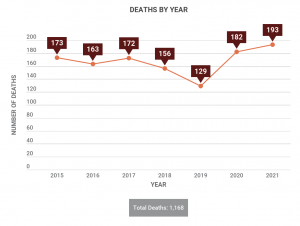
Since our last report analyzing deaths 2015-2019, an additional 375 incarcerated people have died behind bars. Our public records requests also produced documents on an additional 7 deaths that occurred 2015-2019.
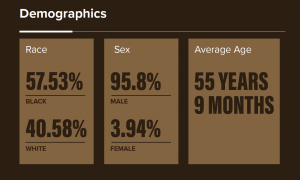
None of the 1,168 known deaths were judicially sentenced to death row. All were either detained before their trial, serving a judicially determined sentence for a set number of years or life, or were detained for a parole or probation violation. The overwhelming majority of people died of medical causes, with the highest rates for heart disease and cancer.
Who is Dying?
Race, Sex, Age & Trial Status
Race
Of the 1,168 known deaths from 2015 to 2021, Black people were 57.53% (672) of deaths and White people were 40.58% (474) of deaths. Of the remaining 22 deaths, nine were listed as Hispanic and the remaining were either listed as “other” or “unknown.”
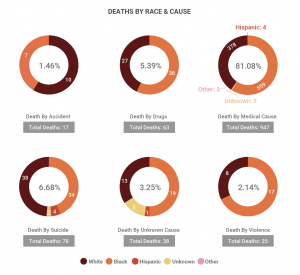
Sex
Of the 1,168 death records reviewed, 95.80% were for men (1119) versus almost 4% for women (46). 2017 was the deadliest year for women, with a peak of 12 deaths.
The percentage of deaths for White women was higher than that of Black women. Black women were 2.68% of all Black deaths and White women were 5.49% of all White deaths. All Hispanic deaths were male.
Women serving sentences are overwhelmingly housed in local jails after the 2016 flooding of the women’s prison in St. Gabriel. At the end of 2021, 65% of the female prison population was housed in a local jail. Approximately 43% of deaths of women occurred in a parish jail, compared to 24% of men.
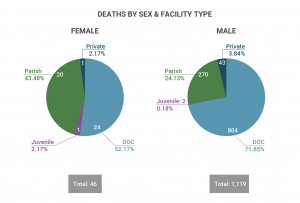
Age
Known deaths behind bars in Louisiana 2015-2021 range in age from 13-96 years old. Overall, people aged 55-60 years old made up 18.49% of deaths, with people aged 61-66 at 16.18% and 49-54 at 13.53%. The average age at time of death was approximately 55 years, 9 months old.
Deaths in parish jails and private facilities skewed younger. People aged 37-42 years old had the highest incidence of death in parish jails (15.41%) and in private facilities, people aged 37-42 and 49-54 tied for highest incidences of death (15.91%).
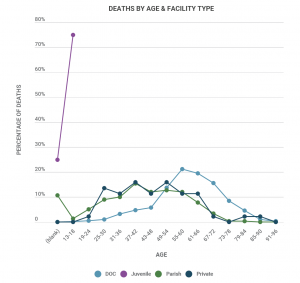
Examining cause of death by age is helpful for understanding which populations are at the highest risk for particular causes of death. For accidental deaths, 29.41% occurred for men aged 61-66. Three out of five of these accidental deaths ages 61-66 involved traumatic brain injuries. Both drug related deaths and suicides skewed younger (aged 37-42) than the overall average age at death and for all other causes of death. Deaths caused by violence were highest for those aged 43-48 years old.
Trial Status
Approximately 86% of known deaths behind bars were of people serving a sentence for conviction of a crime. Deaths of people being held pre-trial, i.e. had not yet had a trial on their criminal charges, constituted 13.44% of all known deaths.
Deaths for people serving convictions occurred primarily within DOC prisons (828 deaths for 70.89% of total deaths), but people with convictions also died serving their sentence in parish jails (132 for 11.3% of deaths), private facilities (40 deaths or 3.42%), and juvenile facilities (2 deaths).
For convicted populations, the mortality rate substantially increased regardless of which type of facility (parish or state) the person died in. For state prisons, the convicted mortality rate in 2021 is 1.6 times higher than in 2015 and for jails, the 2021 rate is 2.2 times higher.
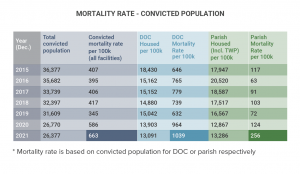
Where are they dying?
Type of Facility, Location within Facility
Type of Facility
Louisiana is relatively unique in the U.S. for using local jails to house approximately 50% of people serving their state sentence in a local jail. Jails are traditionally operated by local sheriffs and are primarily for people detained pretrial. They are designed for short-term housing and therefore often lack more robust services essential for people serving long-term sentences, including appropriate healthcare, recidivism prevention programming, and skills training. Prisons, on the other hand, are operated by the state and are primarily for people serving a judicially determined sentence after being convicted of a crime. As a result of this bifurcated system, the DPSC prioritizes state prison beds for people with longer sentences or serious health needs. Local jails and private operators, such as LaSalle Corrections, house the remaining state population of 50%, in addition to their traditional pretrial populations.
Of the 1,168 known deaths, the majority occurred within state operated prisons, though deaths occurred in all types of facilities during the 2015-2021 period of review.
Parish jails had the largest shares of unnatural deaths, which includes deaths coded as accidental, suicide, drug overdose, and violence. For example, of all suicides, over 61% occurred in parish jails, compared to 29% in state prisons and five percent in private facilities. Similarly, for drug-related deaths, almost 54% occurred in a parish jail. Jails also reported the majority of deaths due to unknown causes. Jails and prisons were tied for percentages of violent deaths.
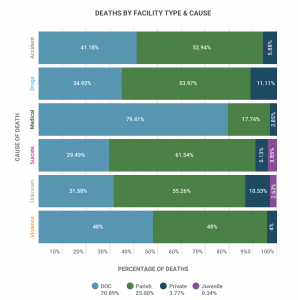
Location of Death within Facility
The majority of deaths (54%) occurred in medical spaces either within the facility or in a few cases, death was pronounced at an external facility. However, deaths occurred in a variety of other spaces within prisons, jails, and youth detention centers, including cells (almost 15%), segregation (3%), and in transit (1%).
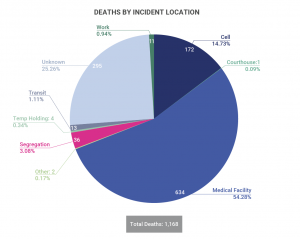
The change in federal data collection has negatively impacted this data point as this information is no longer collected. In the first report analyzing deaths 2015-2019, only 65 death locations (approximately 8%) were unknown. In this report, there were 295 unknown death locations, which was approximately 25% of all deaths 2015-2021.
Unnatural deaths in segregation are particularly concerning, since many facilities have additional restrictions on items that are allowed in segregation cells. Suicides were 2/3 of all known deaths occurring in segregation. Deaths due to drug overdoses were eight percent of all segregation deaths.
When are they dying?
The average number of days incarcerated for all causes of death and all facilities was 4,790 days, or approximately 13 years. The longest average length of incarceration prior to death was for medical-related causes of death, constituting 81% of all deaths 2015-2021. People died of medical related causes on average after 14 and a half years. The shortest average length of incarceration was for deaths due to suicide.
Why are they dying?
Medical, Covid, Suicide, Drugs, Accident, Violence
Over three quarters of known deaths 2015-2021 (81.08%) were related to medical illness according to agency records. The second leading cause of death at 6.68% was completed suicides. Drug overdoses were third at 5.39%. In comparison to the first report analyzing deaths 2015-2019, the percentage of deaths due to medical illness decreased (from 85.75%) and the share of deaths due to drugs (from 3.56%) and suicide (from 6.23%) both increased.
It is important to note that several categories of death may be interrelated. For example, a person’s cause of death may be recorded as accidental, suicide or violent, however in some cases, advocates report that drugs may have played a role in those deaths as well. In addition, deaths may be coded medical by facility, but drugs may have precipitated the medical condition that caused death.
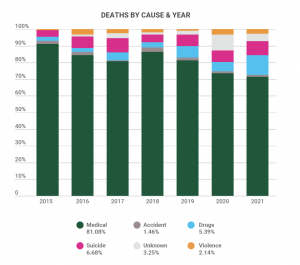
When examined by year, there was a substantial increase in percentage of deaths due to drugs and suicide since 2015. The percentage of deaths caused by drugs rose steeply in 2021 to 11.92% of deaths that year. After several years with lower percentages, violent deaths were a higher share of deaths in 2020 (3.3%) and 2021 (2.59%). The percentage of deaths due to suicide in 2021 (8.29%) is approaching the 2017 peak (8.72%).
Medical
Since 2015, 947 people have died of medical causes behind bars, including 272 people in 2020-2021 alone. People held pre-trial were 8% of medical deaths and people serving convictions (regardless of the type of facility) were 91% of deaths. The leading causes of medical-related deaths behind bars 2015-2021 identified by facility officials were cancer and heart attacks. These percentages are roughly consistent with the 2015-2019 report.
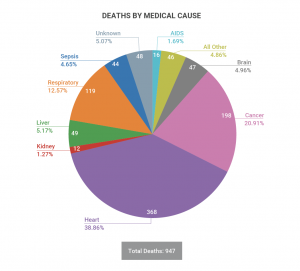
Approximately 13% of known medical deaths from 2015 to 2021 were due to respiratory illness, an increase of 2% from the 2015-2019 percentages. This increase in respiratory deaths as a percentage of all medical deaths was likely the result of COVID-19 (discussed in more detail in the next section). Of the known medical deaths, almost 80% of reported deaths 2015-2021 occurred in state-operated prisons. These percentages are consistent with the distribution of deaths 2015-2019.
Examining deaths by year indicates several categories of medical cause were the highest percentages of deaths for a given year in 2020, including deaths due to brain diseases, cancer, respiratory causes and sepsis. Deaths due to complications from HIV/AIDS appear to be decreasing as a percentage of yearly deaths after a highpoint in 2017. Deaths due to liver and heart disease were highest in 2019 as a percentage of yearly deaths.
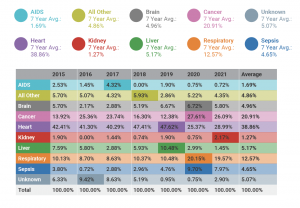
Covid
From January 2020 to December 2021, at least 272 people died behind bars due to medical causes according to administrators of these facilities. Of these 272 people, facility administrators noted COVID-19 in the cause of death descriptions for 48 individuals (approximately 18%). The first officially identified COVID-related death in a Louisiana operated prison or jail in our dataset occurred on April 18, 2020 in Louisiana State Penitentiary (Angola).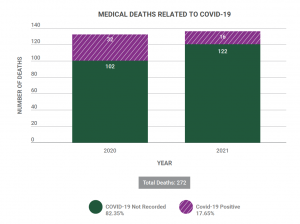
COVID-related deaths were overwhelmingly recorded in prisons (85%) compared to parish jails (14.58%) and almost 96% of COVID-related deaths were of people serving convictions. However, these data points would benefit from additional investigation and analysis due to the higher number of deaths recorded as “unknown” in 2020 and 2021 for both prisons and jails compared to prior years and the lack of uniform guidance for facility officials on identifying COVID-19 on death records.
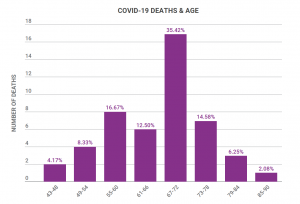
In addition, this analysis of the impact of COVID-19 on deaths behind bars does not include deaths due to suicide, violence, drugs, or accidents. In response to the pandemic, prisons and jails limited or suspended visitation and educational / vocational programming while also increasing the use of isolation within the prison to limit transmission of COVID-19. Facilities also had fewer staff on site due to COVID-19 infections and deaths. These pandemic-related changes in the prison and jail environment may have played a role in the higher numbers of death in 2020 and 2021 for non-medical causes.
Suicide
Known suicide deaths were highest in 2021, comprising 20.51% of all suicide deaths 2015- 2021. The lowest number of suicides by year was seven in 2015 and 2018.
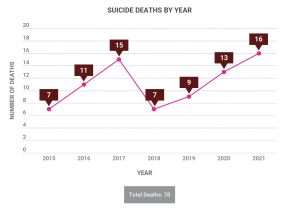
Suicides occurred more frequently in parish jails, contrary to the pattern of medical deaths occurring primarily in state prisons. Over 60% of all known suicides occurred in parish jails. Suicide was also the leading cause of death for youth held in detention. Three of the four deaths in youth detention centers were due to suicide, with details on the cause of death for the fourth child unknown.
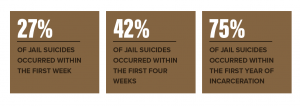
The majority of suicide deaths were of people serving convictions (51%), including convicted people in jails, prisons, and private facilities. People held pre-trial were approximately 46% of suicide deaths.
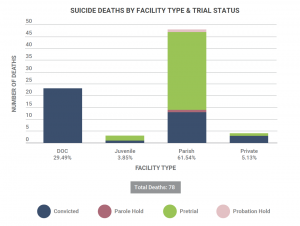
Drugs
Drug related deaths jumped to their highest known levels in 2021, with 23 drug-related deaths comprising almost 37% of all known drug related deaths 2015-2021. Drug-related deaths were 11.92% of all known deaths in 2021. This is a steep increase from 2015, which included 4 drug related deaths comprising 2.31% of all known deaths that year.
Drugs causing death included cocaine, heroin, methamphetamines, fentanyl, ibuprofen, synthetic cannabinoids, and inhaled hydrocarbons. Not all records specified the drug causing death, however, where listed, methamphetamines, heroin, and fentanyl appeared most common.
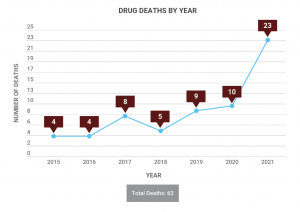
The majority of drug-related deaths occurred in parish jails (54%), impacting people held pre-trial (30%), people serving convictions (22%) and one person held for an alleged parole violation. People held for a conviction (regardless of the type of facility) were 68% of drug-related deaths.
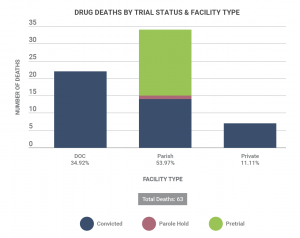
Accident
Deaths due to accidents behind bars primarily involved head injuries leading to traumatic brain injuries. Two of the accidental deaths involved drowning. One involved a person in a work-release program who died from injuries in a car accident.
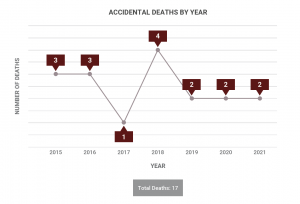
All of the known accidental deaths were male. In contrast to all other categories of death,White men were the majority of deaths by accident (59%) compared to Black men (41%).
Violence
Deaths due to violence, previously the least common cause of death 2015-2019, now outpace accidental deaths and were over 2% of all deaths 2015-2021. Violent deaths have occurred in each calendar year, with a low of one death in 2015 and 2019 and a high of six deaths in 2020. Twenty-four percent of all violent deaths 2015-2021 occurred in 2020.
Five of the deaths involved stabbings by another incarcerated person. Six involved deaths due to significant head injuries received during an assault. Three involved strangulation.
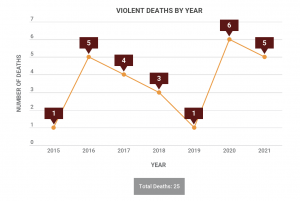
Violent deaths occurred in every type of facility except for juvenile facilities. The number of violent deaths in both prisons and jails also increased. Prisons had zero violent deaths in 2019, but had five violent deaths 2020-2021. Eight of the eleven violent deaths 2015-2021 occurred in Louisiana State Penitentiary (Angola), with one each in Hunt, Wade, and Rayburn prisons.
The deadliest year for jails was in 2016 with six violent deaths and similar to prisons, had zero violent deaths in 2019 but four additional violent deaths 2020-2021. Four of the ten violent deaths occurred in the East Baton Rough Parish jail.
Private facilities had zero violent deaths 2015-2018, but one each year 2019-2021. Though the three violent deaths occurred in different facilities, all three were managed by LaSalle Corrections at the time of death.
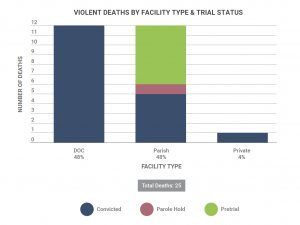
People held pre-trial were 24% of violent deaths and people serving convictions (in all facilities) were approximately 72% of violent deaths.
African-Americans were 68% of all violent deaths 2015-2021, which was higher than their share of deaths overall from all causes (58%). There was only one violent female death.
Conclusion
This report is the second in our Louisiana Deaths Behind Bars series and provides important updates since the first report covering 2015-2019. Unnatural deaths, including suicides, drug overdoses, and violence, dramatically increased in 2020 and 2021.
Prison, jail, and youth detention administrators can and should use this data to compare the operation of their individual facilities to others. In some cases, the trends identified implicate institutional policies and practices, which should be reviewed with the aim of decreasing deaths behind bars.
While not all deaths are necessarily preventable, prisons and jails should ideally have lower death rates than the general public due to the proximity of medical care behind bars, 24-hour staffing and supervision, and reduced probability of certain types of deaths, such as car accidents, due to incarceration.
Thirteen percent of deaths 2015-2021 were of people who had only been accused of a crime, without a chance to prove their innocence or be found guilty. None of the people who died behind bars were judicially sentenced to death.

